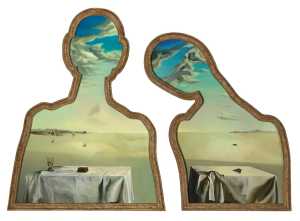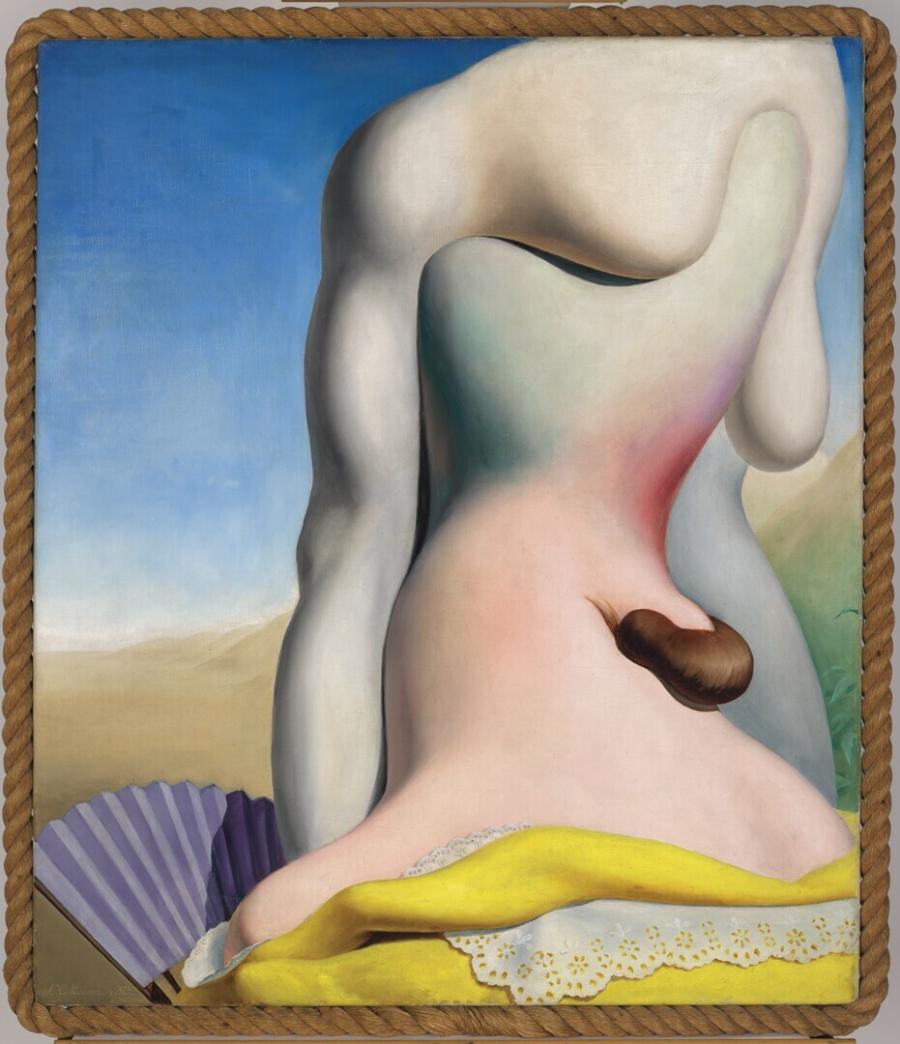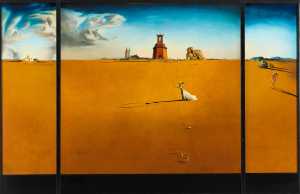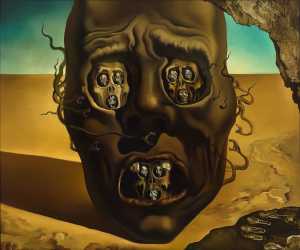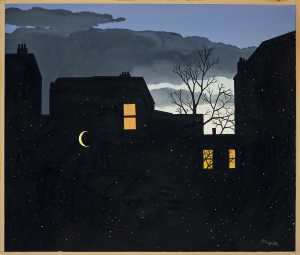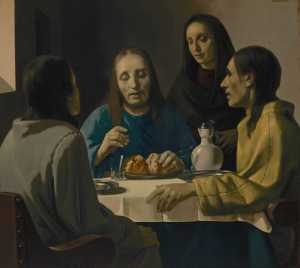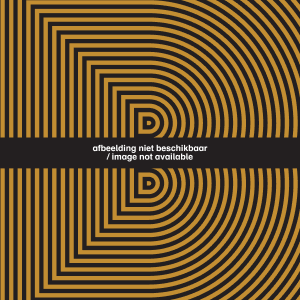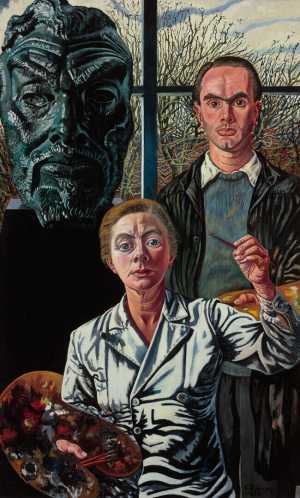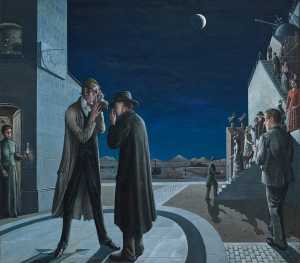‘Afternoon’ is the name of this obscene painting, which predictably caused a riot in the prudish Netherlands of 1932. Moesman had submitted it for an exhibition of the Independent Artists’ Society in the Stedelijk Museum in Amsterdam. The exhibition was closed when the director ordered its removal. Moesman was the only Dutch Surrealist of any note.

Specifications
| Title | Afternoon |
|---|---|
| Material and technique | Oil on canvas with rope frame |
| Object type |
Painting
> Painting
> Two-dimensional object
> Art object
|
| Location | This object is in storage |
| Dimensions |
Depth 3 cm Width 75 cm Height 87 cm |
|---|---|
| Artists |
Artist:
J.H. Moesman
|
| Accession number | BRL 93-04 (MK) |
| Credits | Loan Cultural Heritage Agency of the Netherlands, 1993 |
| Department | Modern Art |
| Acquisition date | 1993 |
| Creation date | in 1932 |
| Provenance | Centraal Museum Utrecht (on loan from the artist) 1971-78; E. Moesman-van Dijk 1988 |
| Exhibitions | Amsterdam 1933; Paris 1933b; Laren 1949; Utrecht 1963; Amsterdam 1966; Bern 1966; Velp 1967; Scheveningen 1969; Amsterdam 1969-70; Utrecht 1970; Utrecht 1971; Amsterdam 1979; Amsterdam 1983-84; The Hague 1990; Laren 1993; Rotterdam 1996b; Arnhem 1998; Rotterdam 2017b |
| Internal exhibitions |
The Collection Enriched (2011) De collectie als tijdmachine (2017) Collectie - surrealisme (2017) Omkijken (2025) |
| External exhibitions |
A Surreal Shock – Masterpieces from Museum Boijmans Van Beuningen (2021) Dal nulla al sogno (2018) De tranen van Eros - Moesman, surrealisme en de Seksen (2020) Surrealist Art - Masterpieces from Museum Boijmans Van Beuningen (2021) Only the Marvelous is Beautiful (2022) |
| Research |
Show research A dream collection - Surrealism in Museum Boijmans Van Beuningen |
| Literature | De Vries/Van der Meulen/Vancrevel 1971, pp. 13, 45; Deurne/Leiden/Leeuwarden 1989, p. 34, 36; Laren 1993, pp. 15, 53, cat. no. 15; Steen 1998, pp. 35, 36, 108, 109, cat. no. 16 |
| Material |
Canvas
> Worked fibres
> Fibre
> Vegetable material
> Organic material
> Material
> Material and technique
|
| Object | |
| Geographical origin | The Netherlands > Western Europe > Europe |
Entry catalogue A dream collection - Surrealism in Museum Boijmans Van Beuningen
Author: Marijke Peyser
J.H. Moesman’s paintings were the result of extensive, time-consuming preparation. This is why his oeuvre amounts to no more than forty paintings which he usually made in his home, in his attic, between twelve and two o’clock during his lunch break, after five o’clock, after one o’clock on Saturday afternoons and on Sundays and holidays.[1] This strict, disciplined schedule had a lot to do with his steady job as a lithographer at Nederlandse Spoorwegen – Dutch Railways. On 31 August 1925 – Moesman was sixteen – he was accepted as a messenger boy at a salary of seven guilders a week. Over the years he rose in the organization. In 1929 Moesman encountered Surrealist works by artists such as Max Ernst, René Magritte, Giorgio de Chirico, Marc Eemans and Pierre Roy. From that time on he developed into a Surrealist painter.
Afternoon is one of the first paintings in which two worlds meet – the everyday and the fantastic – which is typical of Surrealist paintings. The androgynous torso, which takes up almost the whole of the canvas, is built up from body parts that flow around and into one another. The shadow passages were executed in mutually contrasting colours. A lavender-coloured fan and a yellow cloth, with a silky white tablecloth in the middle, terminate the lowest body part. Here Moesman made use of what he called ‘aids’ a term he used for all manner of objects that inspired him. The preliminary sketch shows a torso that consists of a composite figure.[2] The open pair of scissors in the bottom part of the torso does not feature on the canvas. The second ‘aid’ was the oil painting Weib, Greis und Blume (1923-24) by Max Ernst. He probably saw this work in the art magazine Variétés (January 1929).[3]
When he saw the illustration of Magritte’s La trahison des images (1929) – a painting of a pipe with the words ‘ceci n’est pas une pipe’ – in the January 1929 issue of Variétés, Moesman finally realised that a causal connection between words and things was an illusion. From then on the titles Moesman gave his paintings were designed to break free from the image. He said: ‘A title must never give an explanation of the circumstances. It should only make the space for the viewer bigger. I have paintings which are called The Day after Tomorrow, Afternoon and perhaps there will be a painting which will be called The Day before Yesterday. These are all empty words.’[4] The reactions to Afternoon were initially far from positive. Shortly before the opening of the spring exhibition of De Onafhankelijken (The Independents) on 18 February 1933 the then director of the Stedelijk Museum in Amsterdam, Cornelis Wilhelmus Hygenius Baard, removed the painting, which was described as ‘an unnatural and extremely distasteful nude’.[5] After its removal the exhibition remained closed to the public. Baard’s action was supported by almost all of the press. The politician David Wijnkoop was the only one who saw no reason to have removed the painting. He argued that it was ‘just some hanging meat which has no further meaning’.[6]
Footnotes
[1] Steen 1998, pp. 35, 53-56.
[2] Ibid., pp. 172-73: aid CR 16.1 (sketch) pencil on paper 13 x 19.5 cm, J.J. Oskamp Collection.
[3] Ibid., p. 173: aid CR.
[4] Ibid., p. 35.
[5] Ibid., note 87, refers to Jak van der Meulen, ‘Kunst, seks en politiek in 1933-1934’ in De Vries/Van der Meulen/Vancrevel 1971, p. 14.
[6] Jansen/Rogier 1983, pp. 55-59.




